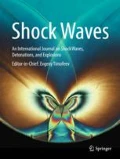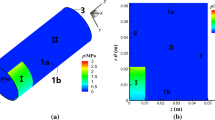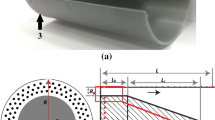Abstract
Rotating detonation engines have the potential to achieve the high propulsive efficiencies of detonation cycles in a simple and effective annular geometry. A two-dimensional Euler simulation is modified to include mixing factors to simulate the imperfect mixing of injected reactant streams. Contrary to expectations, mixing is shown to have a minimal impact on performance. Oblique detonation waves are shown to increase local stream thermal efficiency, which compensates for other losses in the flow stream. The degree of reactant mixing is, however, a factor in controlling the stability and existence of rotating detonations.













Similar content being viewed by others
References
Voitsekhovskii, B.V.: Maintained detonation. Sov. Phys. Dokl. 4(6), 1207–1209 (1959)
Nicholls, J.A., Cullen, R.E.: The feasibility of a rotating detonation wave rocket motor: final report. University of Michigan, ORA Project 05179 (1964)
Bykovskii, F.A., Zhdan, S.A., Vedernikov, E.F.: Continuous spin detonations. J. Propuls Power 22(6), 1204–1216 (2006). doi:10.2514/1.17656
Falempin, F., Le Naour, B.: R&T effort on pulsed and continuous detonation wave engines. 16th AIAA/DLR/DGLR Int. Space Planes and Hypersonic Syst. and Technol. Conf. (2009). doi:10.2514/6.2009-7284
Braun, E.M., Lu, F.K., Wilson, D.R., Camberos, J.A.: Airbreathing rotating detonation wave engine cycle analysis. Aerosp. Sci. Technol. 27(1), 201–208 (2013). doi:10.1016/j.ast.2012.08.010
Nordeen, C.A., Schwer, D.A., Schauer, F.R., Hoke, J., Cetegen, B., Barber, T.: Thermodynamics of rotating detonation performance. Fall Tech. Meet. East. States Sect. Comb, Inst (2011)
Kailasanath, K.: The rotating-detonation-wave engine concept: a brief status report. In: 49th Aerospace science meeting (AIAA), AIAA Paper 2011-580 (2011). doi:10.2514/6.2011-580
Wolanski, P.: Detonative propulsion. Proc. Comb. Inst. 34(1), 125–158 (2013). doi:10.1016/j.proci.2012.10.005
Lee, J.H.S.: The Detonation Phenomenon. Cambridge University Press, NY (2008)
Wintenberger, E., Shepherd, J.E.: Thermodynamic analysis of combustion processes for propulsion systems. In: 42nd Aerospace science meeting (AIAA), AIAA Paper 2004-1033 (2004). doi:10.2514/6.2004-1033
Schwer, D.A., Kailasanath, K.: Effect of inlet on fill region and performance of rotating detonation engines. 47th AIAA/ASME/SAE/ASEE Jt. Propuls. Conf. (2011) doi:10.2514/6.2011-6044
Nordeen, C.A., Schwer, D.A., Schauer, F.R., Hoke, J., Cetegen, B., Barber, T.: Inlet effects on the thermodynamics of a rotating detonation engine. 7th US Natl. Combust. Meet. (2011)
Nordeen, C.A.: Thermodynamics of a Rotating Detonation Engine. PhD Thesis, University of Connecticut (2013). http://digitalcommons.uconn.edu/dissertations/277/
Nordeen, C.A., Schwer, D.A., Schauer, F.R., Hoke, J., Cetegen, B., Barber, T.: Thermodynamic modeling of a rotating detonation engine. In: 49th Aerospace science meeting (AIAA), AIAA Paper 2011-803 (2011). doi:10.2514/6.2011-803
Schwer, D.A., Kailasanath, K.: Thermodynamic properties of a rotating detonation engine. 7th US Natl. Combust. Meet. (2011)
Schwer, D.A., Kailasanath, K.: Numerical investigation of the physics of rotating-detonation-engines. Proc. Comb. Inst. 33(2), 2195–2202 (2011). doi:10.1016/j.proci.2010.07.050
Schwer, D.A., Kailasanath, K.: Numerical study of the effects of engine size on rotating detonation engines. In: 49th Aerospace science meeting (AIAA), AIAA Paper 2011-581 (2011). doi:10.2514/6.2011-581
Nordeen, C.A., Schwer, D.A., Schauer, F.R., Hoke, J., Cetegen, B., Barber, T.: Divergence and mixing in a rotating detonation engine. In: 51st Aerospace science meeting (AIAA), AIAA Paper 2013-1175 (2013). doi:10.2514/6.2013-1175
Li, C., Kailasanath, K., Oran, E.S.: Detonation structures behind oblique shocks. Phys. Fluids 6(4), 1600–1611 (1994). doi:10.1063/1.868273
Schwer, D.A., Kailasanath, K.: Fluid dynamics of rotating detonation engines with hydrogen and hydrocarbon fuels. Proc. Combust. Inst. 34(2), 1991–1998 (2013). doi:10.1016/j.proci.2012.05.046
Kailasanath, K., Oran, E.S., Boris, J.P., Young, T.R.: Determination of detonation cell size and the role of transverse waves in two-dimensional detonations. Combust. Flame 61(3), 199–209 (1985). doi:10.1016/0010-2180(85)90101-4
Versteeg, H.K., Malalasekera, W.: An Introduction to Computational Fluid Dynamics: the Finite Volume Method. Pearson Education Ltd., Edinburgh Gate (2007)
Tellefsen, J.R., King, P.I., Schauer, F.R., Hoke, J.L.: Analysis of an RDE with convergent nozzle in preparation for turbine integration. In: 50th Aerospace science meeting (AIAA), AIAA Paper 2012-773 (2012). doi:10.2514/6.2012-773
Lyman, F.A.: On the conservation of rothalpy in turbomachines. J. Turbomach. 115(3), 520–526 (1993)
Nordeen, C.A., Schwer, D.A., Schauer, F.R., Hoke, J., Barber, T., Cetegen, B.: Energy transfer in a rotating detonation engine. 47th AIAA/ASME/SAE/ASEE Joint Propulsion Conference, AIAA Paper 2011-6045 (2011). doi:10.2514/6.2011-6045
Bykovskii, F.A., Vedernikov, E.F.: Continuous detonation of a subsonic flow of a propellant. Combust. Explos. Shock Waves 39(3), 323–334 (2003). doi:10.1023/A:1023800521344
Bykovskii, F.A., Zhdan, S.A., Vedernikov, E.F.: Continuous spin detonation of hydrogen-oxygen mixtures. 1. annular cylindrical combustors. Combust. Explos. Shock Waves 44(2), 150–162 (2008). doi:10.1007/s10573-008-0021-1
Bykovskii, F.A., Zhdan, S.A., Vedernikov, E.F.: Continuous detonation in the regime of nonstationary ejection of the oxidizer. Dokl. Phys. 54(1), 29–31 (2009). doi:10.1134/S102833580901008X
Kessler, D.A., Gamezo, V.N., Oran, E.S.: Gas-phase detonation propagation in mixture composition gradients. Philos. Trans. R. Soc. A 370(1960), 567–96 (2012). doi:10.1098/rsta.2011.0342
Nordeen, C.A., Schwer, D.A., Schauer, F., Hoke, J., Barber, T., Cetegen, B.: Thermodynamic model of a rotating detonation engine. Combust. Explos. Shock Waves 50(5), 568–577 (2014). doi:10.1134/S0010508214050128
Schwer, D.A., Kailasanath, K.: Feedback into mixture plenums in rotating detonation engines. 50th Aerospace science meeting (AIAA), AIAA Paper 2012-617 (2012). doi:10.2514/6.2012-617
Acknowledgments
This work was sponsored by a contract from Innovative Scientific Solutions, Inc. and by the Office of Naval Research through the NRL 6.1 Computational Physics Task Area.
Author information
Authors and Affiliations
Corresponding author
Additional information
Communicated by J. Yang.
Electronic supplementary material
Below is the link to the electronic supplementary material.
Rights and permissions
About this article
Cite this article
Nordeen, C.A., Schwer, D., Schauer, F. et al. Role of inlet reactant mixedness on the thermodynamic performance of a rotating detonation engine. Shock Waves 26, 417–428 (2016). https://doi.org/10.1007/s00193-015-0570-7
Received:
Revised:
Accepted:
Published:
Issue Date:
DOI: https://doi.org/10.1007/s00193-015-0570-7




